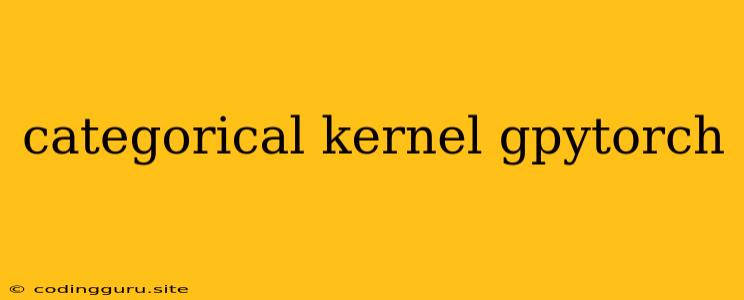Understanding Categorical Kernels in GPyTorch: A Comprehensive Guide
GPyTorch is a powerful library for building deep Gaussian processes (GPs). One of the key strengths of GPyTorch lies in its ability to handle diverse data types, including categorical data. This is achieved through the use of categorical kernels, which are designed to capture relationships between discrete variables.
Let's delve into the world of categorical kernels and explore how they enhance the capabilities of GPyTorch for modeling data with categorical features.
What are Categorical Kernels?
Categorical kernels are a specialized type of kernel function used in Gaussian processes to handle data with discrete, categorical features. Imagine you are trying to model the relationship between a person's favorite color (e.g., red, blue, green) and their favorite animal (e.g., cat, dog, bird). A categorical kernel can effectively capture the underlying structure of this type of data.
Categorical kernels work by measuring the similarity between two data points based on their categorical values. They are constructed in a way that accounts for the discrete nature of the categories.
Why Use Categorical Kernels?
Categorical kernels provide several advantages when modeling data with categorical features:
- Handling Discrete Data: Traditional kernels, like the RBF kernel, are designed for continuous data. Categorical kernels allow you to leverage GPs to model datasets with discrete attributes.
- Capturing Relationships: Categorical kernels can capture complex relationships between categorical variables, such as those related to preferences, classifications, or discrete states.
- Enhanced Model Flexibility: The use of categorical kernels expands the flexibility of GPyTorch models, enabling you to build richer models that can handle diverse data types.
Common Types of Categorical Kernels
GPyTorch offers a variety of categorical kernels to suit different data structures and modeling needs. Some common examples include:
- CategoricalKernel: This is a basic categorical kernel that assigns a similarity score based on whether two categorical values are identical.
- MaternKernel: While not strictly a categorical kernel, the Matern kernel can be used with categorical features by encoding them as one-hot vectors. This allows for capturing relationships between categorical variables based on their proximity in a multi-dimensional space.
Examples of Using Categorical Kernels in GPyTorch
Let's see a simple example to illustrate how to implement categorical kernels in GPyTorch:
import gpytorch
import torch
# Define the categorical features
categories = ['red', 'blue', 'green', 'yellow']
data = torch.tensor([
['red', 'dog'],
['blue', 'cat'],
['green', 'bird'],
['yellow', 'cat'],
['red', 'bird'],
])
# Create a Categorical kernel
kernel = gpytorch.kernels.CategoricalKernel(categories=categories)
# Calculate the kernel matrix
kernel_matrix = kernel(data[:, 0], data[:, 0])
In this example, the CategoricalKernel calculates the similarity between different color values. The resulting kernel_matrix will reflect the pairwise relationships between the colors based on the defined categories.
Building Complex Models with Categorical Kernels
Categorical kernels can be combined with other kernels to create more sophisticated models. For example, you might combine a categorical kernel with a RBF kernel to capture relationships between both categorical and continuous features.
Best Practices for Using Categorical Kernels
- Proper Feature Encoding: Ensure that your categorical features are appropriately encoded before using categorical kernels. One-hot encoding is a common approach.
- Kernel Selection: Choose the appropriate categorical kernel based on the nature of your data and the relationships you are trying to capture.
- Hyperparameter Tuning: Tune the hyperparameters of your categorical kernel to optimize the model's performance.
Conclusion
Categorical kernels are a powerful tool for building effective Gaussian process models that can handle categorical data. By incorporating categorical kernels, GPyTorch allows you to model diverse datasets with greater flexibility and accuracy.
Understanding and leveraging categorical kernels in GPyTorch empowers you to develop richer and more comprehensive models, leading to deeper insights from your data.
